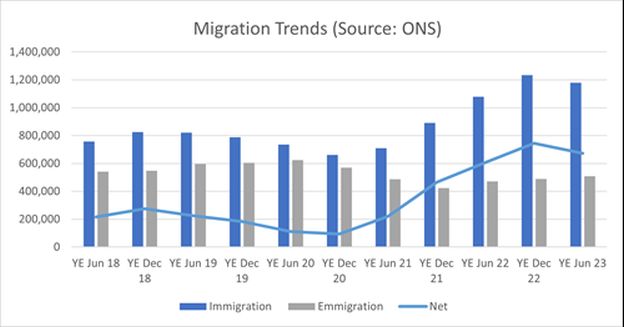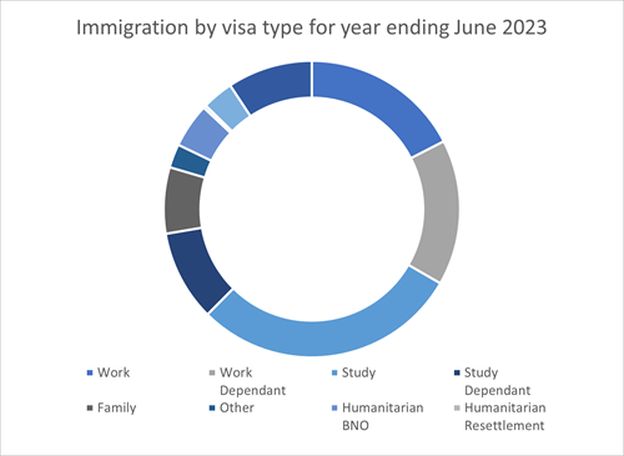This week has seen some sharp debate around the release of migration statistics, including barbed criticism of the Government for perceived failure to deliver on a Brexit promise. Stacey Lambert, Associate in Wright Hassall's Business Immigration team, takes a closer look.
Is UK net migration too high?
Ministerial debate often returns to this question. Generally, the message broadcast to the UK public in media headlines is that the Government intends to drive down net migration figures.
Recently, veteran Tory MP Sir Edward Leigh shared his perspective, describing care worker visas as being handed out 'like sweeties'. With heightened calls for further managing the levels of migration Home Office Minister Robert Jenrick has promised a 'serious package of fundamental reform'.
What does net migration mean?
Net migration is the difference between the level of immigration and emigration.
Long-term immigration for the year of 2022 was 1.2 million. This includes individuals arriving in the UK (not visiting) who include non-EU national, EU national and returning British nationals.
Emigration was recorded as 508,000. This is people leaving the UK for the long-term.
UK migration figures
For the year ending June 2023 net migration was recorded as 672,000. This is an increase on the previous year (607,000) but still less than the estimated levels of net migration (745,000). Could this be the first year of a general downturn in the level of immigration, especially if the Government adopts a policy to cap immigration numbers? Even if it is, there is a long way to go to get back to the pre-Brexit 2019 figure of 226,000 – when the Government was still promising Brexit would deliver further falls rather than the big increase that followed.

Why are people immigrating to the UK?
People immigrate to the UK for many reasons. Common examples include work purposes, study or to benefit from on-off humanitarian routes such as the Ukrainian Schemes or those implemented for British National Overseas (BN(O) passport holders from Hong Kong.
In 2022, non-EU immigration for work purposes increased by 10%, with a significant proportion of these being health and care visas. Perhaps this is the root of Sir Edward Leigh's comments?
The number of non-EU immigration for study remains largely the same when compared the previous year. However, the data indicates that more students are staying in the UK for longer and transitioning to work visas. Does this suggest the plan to attract and retain the 'brightest and best from around the world' is materialising and achieving the intended results, or is just cooling the labour market further and suppressing graduate wages?

Past & Future UK immigration changes to curb immigration levels
The end of free moment for EU nationals (Brexit) and the relaxation of Covid-19 pandemic travel restrictions clearly corelates with net migration levels. Whilst immigration of EU nationals appears to have slowed, the immigration levels of non-EU nationals has significantly increased.
Home Office visa fees increased on 25 October 2023 which may have discouraged some sponsor and applicants. These included the CoS fee (now £239), most visa application fees and fast-track fees, e.g. the priority service is now £500 regardless of the applicants' location.
The Immigration Health Surcharge (IHS) which is in place to ensure migrants contribute towards the NHS healthcare costs will rise to £1,035 (full rate) and £776 (discounted rate) per year of leave. This takes effect on 16 January 2024. We did not see a rise in the Immigration Skills Charge; could this be next?
The Immigration Rules are tightening for international students. They may only switch to a work route after completing their studies and most will be unable bring Dependants to the UK from January 2024.
The MAC (The Migration Advisory Committee) has advised significant reform or removal of the shortage occupation list. The 2023 report summarising the MAC finding of its review of the Shortage Occupation List may have increased scrutiny on the salary thresholds (and discounted reductions) that are in place under the current rules.
However, at present, Robert Jenrick is yet to provide any insights into his proposals for reform.
Data from the Office of National Statistics.
The content of this article is intended to provide a general guide to the subject matter. Specialist advice should be sought about your specific circumstances.

